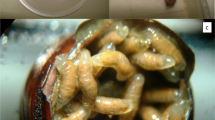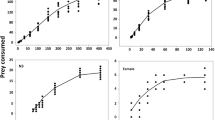Abstract
Factors stimulating host seeking behaviour of Eocanthecona furcellata (Wolff), a pentatomid predator, were investigated by using Spodoptera litura (Lepidoptera: Noctuidae) as prey. Faeces of S. litura larvae elicited a host seeking response by the predators. The active material is present in the prey mandibular gland secretions, digestive tract and body surface, which when placed on a filter paper evoked feeding attempts. Predators responded intensely towards the prey artificial diet too. Prey body washings with hexane and acetone also stimulated feeding behaviour.
Physical stimuli such as host shape or movement had no influence on acceptability of the prey to the predator. Larval size correlated with aggressive behaviour which limited predation rather than releasing stimulus for the host acceptance behaviour. Pharate instar stage of the prey was never accepted by E. furcellata. But pupal, egg and adult stages of S. litura stimulated predators to certain extent.
Neither extirpation of antennae nor blinding the vision prevented the bugs from locating the prey. However, excision of rostral tip decreased the prey capture efficiency. It is suggested that the rostral tip contains chemotactile sensillae which are responsible for the prey detection.
Résumé
Les agents qui stimulent l’hôte recherchant la conduite (on le comportement) due Eocanthecona furcellata, (c’est à-dire un mammifére à fourrure, comme le loup), un prédateur pentatome, furent examinés comme proie en utilisant le Spodoptera litura (lépidoptères nocturlles). Les fèces de la larve S. litura decouvrirent un hôte recherchant une réponse des prédateurs. La matière active est présente dans les glandes sécrétoires, le conduit digestif et à la surface du corps de la proie mandibulaire, qui, mise sun un papier filtre, susita des tentatives (on des efforts) faites envers la nourriture. Les prédateurs répondirent aussi vivement à la diète artificielle de la proie. Les lavages du corps de la proie à l’hexane et a l’acètone stimulirent aussi le comportement envers la nourriture. Le stimuli physique, comme par exemple, la forme de l’hôte on son mouvement, n’eut aucune influence sur l’acceptabilité’ de la proie vers le prédateur. La grandeur (on la taille, dimension) de la larve correspondait à la conduite agressive qui borna la prédation, an lieu de libérer le stimulus de sorte que le comportment de l’hôte l’accepta.
L’etape “pharate instar” de la proie ne fut jamais acceptée par E. furcellata. Mais la pupe, l’oeuf (l’ovule) et les étapes adultes de S. litura stimulèrent les prédateurs jusqu’à un certain point.
Nil l’extirpation de l’antenne et du tarsien, ni l’aveuglement de la vision empêchèrent les punaises à repérer la proie. Cependant, l’excision du bout rostral diminua l’efficacite’ de la capture de la proie. On a suggéré que le bout rostral contient des “sensillae” chimotactiles qui sont responsables à détecter (on à découvrier) la proie.
Similar content being viewed by others
References
Arthur A. P. (1981) Host acceptance by parasitoids. In Semiochemicals Their Role in Pest Control (Edited by Nordlund D. A., Jones R. L. and Lewis W. J.), pp. 97–120. John Wiley and Sons, NY.
Bragg D. (1974) Ecological and behavioural studies of Phaegenes cynaerae: Ecology, host specificity, search and oviposition; and avoidance of superparasitism. Ann. Entomol. Soc. Am. 67, 931–936.
Corbet S. A. (1971) Mandibular gland secretion of larvae of the flour moth, Anagasta kuehnella contains an epideictic pheromone and elicits oviposition movements in a hymenopteran parasite. Nature 232, 481–484.
Edwards E. S. (1962) Observations on the development and predatory habit of two reduvid Heteroptera, Rhinocoris carmelita Stal., and Platymeris rhadamanthus Gerst. Proc. R. Entomol. Soc. Lond. 37, 89–98.
Ghorpade K. D. (1972) Predaceous pentatomid Cantheconidea furcellata (Wolff) attacking Latoia lepida (Cramer) on mango near Bangalore. J. Bombay Nat. Hist. Soc. 72, 596–598.
Gope B. (1981) A promising predator of Bihar hairy caterpillar and bunch caterpillar. Two and a Bud 28, 47–48.
Hays D. and Vinson S.B. (1971) Host acceptance by the parasite Cardiochiles nigriceps Viereck. Anim. Behav. 19, 344–352.
Hendry L. B., Greany P. D., and Gill R. J. (1973) Kairomone mediated host finding behaviour in the parasitic wasp Origilus lepidus. Entomol. Exp. Appl. 16, 471–477.
McLain D. K. (1979) Terrestrial trail-following by three species of predatory stink bugs. Flor. Entomol. 62, 153–154.
Isenhour D. J. (1985) Compoletis sonerensis (Hymenoptera: Ichneumonidae) as a parasitoid of Spodoptera frugiperda (Lepidoptera: Noctuidae): Host stage preference and functional response. Entomophaga 30, 31–36.
Jones R. L., Lewis W. J., Bowman M. C. J., Beroza M. and BierlB. A. (1971) Host seeking stimulant for parasite of corn earworm: isolation, identification and synthesis. Science 173, 842–843.
Monteith L. G. (1956) Influence of host movement on selection of host by Drino bohemica Mesn. as determined in an olfactometer. Can. Entomol. 88, 583–586.
Mudd A. and Corbet S. A. (1973) Mandibular gland secretion of larvae of the stored products pests Anagasta kuehniella, Ephestia cautella, Plodia interpunctella and Ephestia elutella. Entomol. Exp. Appl. 16, 291–293.
Rai P. S. (1978) Cantheconidea furcellata (Wolff) (Pentatomidae: Heteroptera) A predator of leaf feeding caterpillar of rice. Curr. Sci. 47, 556–557.
Richerson J. V. and DeLoach C. J. (1972) Some aspects of host selection by Perlitus coccinellae. Ann. Entomol. Soc. Am. 65, 834–840.
Smith O. J. (1952) Biology and behaviour of Microtonus vittatae Muesebeck. Univ. Calif. Berkeley Publ. Entomol. 9, 315–344.
Usha Rani and Kaiser Jamil (1990) Chemosensory responses of cowpea weevil, Callosobruchus chinensis to an aquatic weed, water hyacinth, Eichhornia crassipes (Mart.) Solms. J. Chem. Ecol. 16, 1269–1275.
Vinson S.B. (1968) Sourceofasubstance in Heliothis virescens that elicits a searching response in its habitual parasite, Cardiochiles nigriceps. Ann. Entomol. Soc. Am. 61, 8–10.
Vinson S. B., Barfield C. S. and Henson R. D. (1977) Oviposition behaviour of Bracon mellitor, a parasitoid of the boll weevil (Anthonomus grandis). II. Associative learning. Physiol. Entomol. 2, 157–164.
Wakamura S. (1988) Rearing of the beet armyworm, Spodoptera exigua (Hubner) (Lepidoptera: Noctuidae), on artificial diet in the laboratory. Jpn. J. Appl. Entomol. Zool. 32, 329–331.
Weseloh R. M. (1971) Influence of primary (parasite) host on host selection of the hyperparasite Cheilonèurus noxius (Hymenoptera: Encry tidae). Ann. Entomol. Soc. Am. 64, 1233–1236.
Weseloh R. M. (1977) Effects of behaviour of Apanteles melanoscelus females caused by modification in extraction, storage and presentation of gypsy moth silk kairomone. J. Chem. Ecol. 3, 723–735.
Author information
Authors and Affiliations
Rights and permissions
About this article
Cite this article
Rani, P.U., Wakamura, S. Host Acceptance Behaviour Of A Predatory Pentatomid, Eocanthecona Furcellata (Wolff) (Heteroptera: Pentatomidae) Towards Larvae of Spodoptera Litura (Lepidoptera: Noctuidae). Int J Trop Insect Sci 14, 141–147 (1993). https://doi.org/10.1017/S1742758400014521
Received:
Accepted:
Published:
Issue Date:
DOI: https://doi.org/10.1017/S1742758400014521




